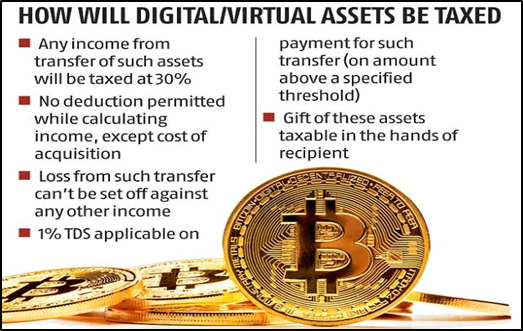In News:
- The Central Board of Direct Taxes (CBDT) recently issued detailed guidelines on the tax deducted at source (TDS) rule for virtual digital assets (VDAs) such as cryptocurrencies.
- It lays out the various scenarios on how the tax will be applicable and who will bear the onus to deduct it.
- With the addition of Section 194S to the Income-tax Act via the Finance Act of 2022, a 1% TDS will be levied on transfers of VDAs beginning July 1 if the value of transactions exceeds Rs 10,000 in a year.
What’s in today’s article:
- Virtual Digital Assets vs Virtual Currency (About virtual digital assets, how are they different from digital currency, Budget 2022-23 announcement)
- News Summary (Guidelines laid down by the CBDT, first impression on these guidelines)
Virtual Digital Assets vs Virtual Currency:
About virtual digital assets:
- According to the Finance Act, a virtual digital asset means any information or code or number or token (not being Indian currency or any foreign currency), generated through cryptographic means or otherwise.
- The definition includes non-fungible tokens (unique and can't be replaced with something else) as well as other tokens of a similar nature.
- It provides a digital value that is exchanged for, with the promise of having inherent value or functions as a store of value or a unit of account and includes its use in any financial transaction or investment.
- This means, it is not limited to investment schemes and can be transferred, stored or traded electronically.
How are virtual digital assets different from digital currency?
- A currency is a currency only when it is issued by the central bank (RBI in India) of that country.
- If a virtual currency (be it a cryptocurrency) is recognised by the central bank it is known as the Central Bank Digital Currency (CBDC).
- CBDCs are the virtual or electronic form of fiat currencies (like the Indian rupee). Hence, a CBDC is the legal tender issued by a central bank in a digital form.
- CBDC cannot be compared to the private virtual currencies (VCs) that have proliferated in the last decade.
- VCs are not money (certainly not currency), as the term has historically been understood.
CBDC and Budget 2022-23
- The government (in the Budget 2022-23) has proposed to issue a Digital Rupee or CBDC, in the fiscal year 2022-23.
- According to the Finance Minister (in her Budget 2022-23 speech), everything other than a Digital Rupee or CBDC is a digital asset created by individuals and the government will tax the profits made during transactions of such assets at 30%.
- Tax Deduction at Source (TDS) will be levied at a rate of 1% on payments for the transfer of crypto assets above a certain threshold.
- Furthermore, gifts of crypto assets will be taxed in the hands of the recipient.

News Summary:
Guidelines laid down by the CBDT:
- In various cases, the CBDT has defined who is responsible for deducting the tax.
- For example, if a VDA transfer occurs on or through an exchange and the VDA being transferred is not owned by the exchange, tax may be deducted by the exchange when it pays the seller.
- This mainly deals with situations where the transfer of a VDA is being made against money.
- The CBDT has also provided examples of cases in which a VDA is transferred in exchange for another VDA.
- For example, if two different cryptocurrencies, such as Bitcoin and Ether, are exchanged, both parties are considered buyers and sellers.
- As a result, both will have to pay tax on the cryptocurrency transfer.
- In these cases, the guidelines also allow exchanges that facilitate such transactions to deduct tax.
- Additionally, the CBDT has defined four primary VDAs - Bitcoin, Ether, USD Tether and USD Coin, for the purpose of tax deduction on lesser-known cryptocurrencies.
First impression on these guidelines:
- In general, the responsibility for deducting TDS has been placed on the exchanges, which will increase their regulatory and compliance burden.
- The exchanges must also disclose these transactions in their tax returns and keep a proper trail.
- However, both buyers and sellers would benefit from this.
- Because they can enter into contracts with the exchange for passing the responsibility to deduct tax on their behalf in VDA-to-VDA transfers or otherwise.
- Overall, the CBDT has successfully clarified several open issues that had been a source of contention in the professional community.
- However, several of the CBDT's recommendations, particularly those concerning the documents required (agreements, challans, undertakings, etc.) to be maintained between the transacting parties, may be impractical.










